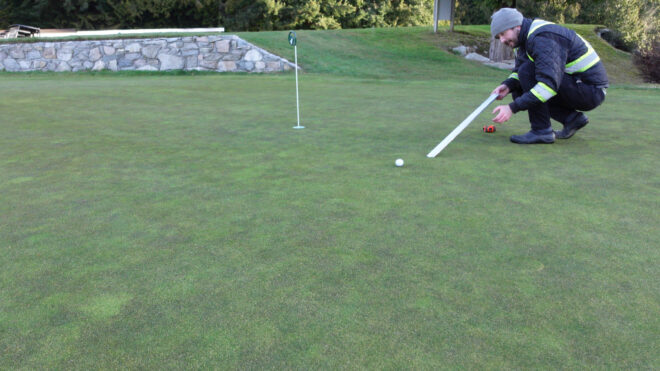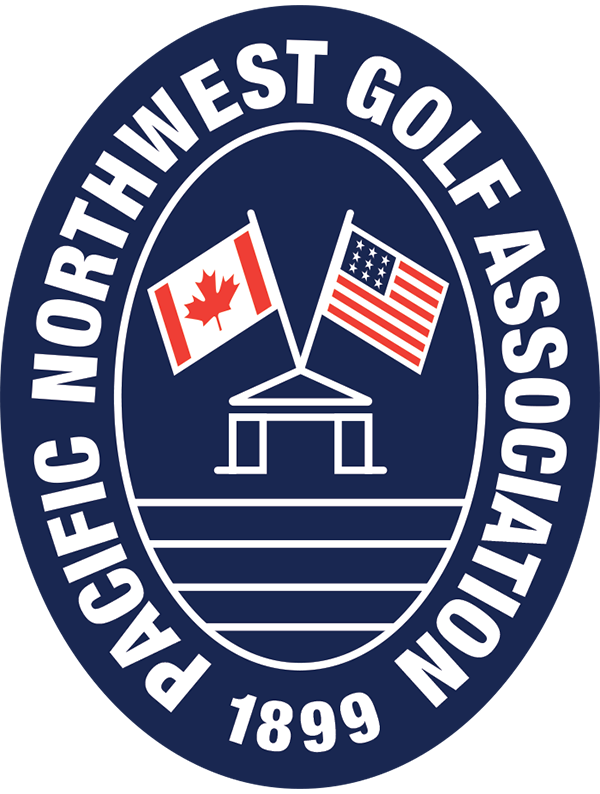He’s a Keeper
Derided by a few as a ‘snowflake superintendent,’ Jason Haines impresses most as a golf course game-changer
by Jim Sutherland

In a just world, great greenkeepers would be famous, but for now Jason Haines is as close as B.C. is going to get.
The 37-year-old has been flown all over North America to speak at industry gatherings like the annual PGA Show and to share his knowledge and approach with other greenkeepers. Europe too: he’s been hosted in Denmark, the Netherlands, Ireland and Iceland.
His message is both very alluring and disarmingly simple, even if much less simple to achieve. He says—and demonstrates on the ground—that it’s possible to dramatically reduce fertilizer and pesticide usage and costs, with no adverse consequences for turf health or playability.
Surprisingly perhaps, Haines has spent his entire career a long way from the big-city limelight, first at the nine-hole Pender Harbour Golf Club in Madeira Park, B.C., then for the past three years at the less obscure but still remote Sunshine Coast Golf and Country Club in Roberts Creek.
A Sunshine Coast native, Haines is well into his third decade of greenkeeping, since he was just 15 when he got his first job at the Pender Harbour course. “I thought I was the luckiest kid in town because I got paid to drive a golf cart around and weed whack all day,” he says.
Academically inclined, Haines was destined to be something like an engineer, his teachers believed. Instead, he passed on university to take a one-year course in turf management at Fairview College in Alberta’s Peace River region, before returning to the Sunshine Coast.
At the age of 22 he was already in charge of operations at Pender Harbour. “In 2007 I became super,” he says. “In 2008 the recession hit.”
Suddenly Haines had no staff and no money. “I think it’s Churchill who’s credited with ‘Never let a good crisis go to waste,’” he says. “When your hand is forced, you have an opportunity to take risks.”
One of the first eye-openers was attending a talk by turf specialist Armen Suny, whom Richard Zokol brought in as a co-designer with Rod Whitman at Sagebrush Golf Club, which was then in development near Merritt, B.C.
“Back then the term they used was ‘minimalism,’” Haines says. “These guys were talking about how it’s cool to be poor, to not spend money, to not put a ton of fertilizer out there.”
Next up, Haines discovered an American turf guru named Micah Woods, with a related but more focused approach that he terms Minimum Level of Sustainable Nutrition, or MLSN, which seeks to accurately and precisely identify nutrients present in the soil in order to avoid unnecessary fertilization.
“I was one of the first people in the world to adopt it,” Haines says. “I had the need to reduce fertilizer use, so I did, and 10 years later it still works.”
Around the same time Haines also discovered blogging. His first, called Turf Hacker, quickly gained an audience, one consisting mostly of fans, but also including at least a couple of bitter critics who termed him a “snowflake superintendent” for reducing chemical usage while allowing his grass to sometimes become slightly less verdant. Turf Hacker recently disappeared, and was replaced by Haines’ new blog.
The one thing instantly clear from reading the blogs is how much analytical work Haines puts in. He maintains a well-equipped on-site lab and spends a considerable chunk of his time there, while also keeping careful records over time.
Testing goes well beyond soil nutrients to include, for example, total organic matter by depth, which helps him determine how much sand to add as top dressing.
Then there are clipping volumes, which are measured with every mowing, with the numbers run through a calculation devised by Haines. “This shows me how I am growing my grass in relation to the weather and guides my fertilizer and plant growth regulator applications,” he says.
The lab work has led to several operational changes. He’s converted almost entirely to liquid fertilizers from granular, switched up the kind of sand he uses, and determined that he can keep his greens both healthier and faster by mowing less and rolling more. He’s also managed to cut back his water usage.
Although geared primarily to playability and turf health, most of these changes have had the additional benefit of reducing costs. But as helpful as those savings may be, they pale compared to the reduction in his fertilizer and pesticide bills.
At Sunshine Coast, the cost per hectare for fertilizer in 2018, before his arrival, was about $725. Over the past three years it’s been averaging around $200 – an 80% decrease by volume, even as fertilizer prices have risen. Meanwhile, pesticides have been reduced by about half.
All in, Haines is spending about $50,000 less annually on chemicals, at a time when the golf industry is being challenged to reduce potential environmental effects as well as costs.
There’s a happy ending to this story about an almost famous greenkeeper – for Haines at least, if not necessarily for B.C. In mid-March he accepted a new position, and began in early April, to be the head greenkeeper at Cabot Links on Cape Breton Island in Nova Scotia.
He’ll be moving from one isolated golf outpost to another, but this one will carry a little more profile. According to Golf Digest, Cabot Links is ranked the 39th best course outside the U.S.
The kid has earned it.
Jim Sutherland is a former editor of Vancouver and Western Living magazines in British Columbia who amuses himself by writing humorous novels with a golf connection, including Snap Slice (2013) and Good Grief (2020), both set in the Pacific Northwest and available on Amazon.






